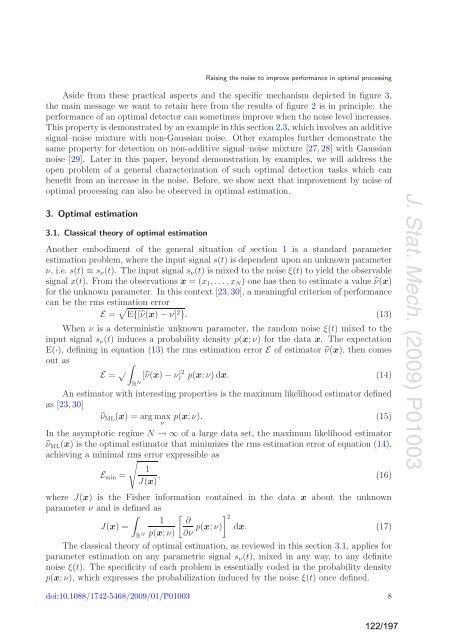a la physique de l'information - Lisa - Université d'Angers
a la physique de l'information - Lisa - Université d'Angers
a la physique de l'information - Lisa - Université d'Angers
You also want an ePaper? Increase the reach of your titles
YUMPU automatically turns print PDFs into web optimized ePapers that Google loves.
Raising the noise to improve performance in optimal processing<br />
Asi<strong>de</strong> from these practical aspects and the specific mechanism <strong>de</strong>picted in figure 3,<br />
the main message we want to retain here from the results of figure 2 is in principle: the<br />
performance of an optimal <strong>de</strong>tector can sometimes improve when the noise level increases.<br />
This property is <strong>de</strong>monstrated by an example in this section 2.3, which involves an additive<br />
signal–noise mixture with non-Gaussian noise. Other examples further <strong>de</strong>monstrate the<br />
same property for <strong>de</strong>tection on non-additive signal–noise mixture [27, 28] with Gaussian<br />
noise [29]. Later in this paper, beyond <strong>de</strong>monstration by examples, we will address the<br />
open problem of a general characterization of such optimal <strong>de</strong>tection tasks which can<br />
benefit from an increase in the noise. Before, we show next that improvement by noise of<br />
optimal processing can also be observed in optimal estimation.<br />
3. Optimal estimation<br />
3.1. C<strong>la</strong>ssical theory of optimal estimation<br />
Another embodiment of the general situation of section 1 is a standard parameter<br />
estimation problem, where the input signal s(t) is <strong>de</strong>pen<strong>de</strong>nt upon an unknown parameter<br />
ν, i.e. s(t) ≡ sν(t). The input signal sν(t) is mixed to the noise ξ(t) to yield the observable<br />
signal x(t). From the observations x =(x1,...,xN) one has then to estimate a value ν(x)<br />
for the unknown parameter. In this context [23, 30], a meaningful criterion of performance<br />
can be the rms estimation error<br />
E = E{[ν(x) − ν] 2 }. (13)<br />
When ν is a <strong>de</strong>terministic unknown parameter, the random noise ξ(t) mixed to the<br />
input signal sν(t) induces a probability <strong>de</strong>nsity p(x; ν) for the data x. The expectation<br />
E(·), <strong>de</strong>fining in equation (13) the rms estimation error E of estimator ν(x), then comes<br />
out as<br />
<br />
√<br />
E = [ν(x) − ν] 2 p(x; ν)dx. (14)<br />
R N<br />
An estimator with interesting properties is the maximum likelihood estimator <strong>de</strong>fined<br />
as [23, 30]<br />
νML(x) = arg max p(x; ν). (15)<br />
ν<br />
In the asymptotic regime N →∞of a <strong>la</strong>rge data set, the maximum likelihood estimator<br />
νML(x) is the optimal estimator that minimizes the rms estimation error of equation (14),<br />
achieving a minimal rms error expressible as<br />
<br />
1<br />
Emin = , (16)<br />
J(x)<br />
where J(x) is the Fisher information contained in the data x about the unknown<br />
parameter ν and is <strong>de</strong>fined as<br />
<br />
J(x) =<br />
RN 2 1 ∂<br />
p(x; ν) dx. (17)<br />
p(x; ν) ∂ν<br />
The c<strong>la</strong>ssical theory of optimal estimation, as reviewed in this section 3.1, applies for<br />
parameter estimation on any parametric signal sν(t), mixed in any way, to any <strong>de</strong>finite<br />
noise ξ(t). The specificity of each problem is essentially co<strong>de</strong>d in the probability <strong>de</strong>nsity<br />
p(x; ν), which expresses the probabilization induced by the noise ξ(t) once <strong>de</strong>fined.<br />
doi:10.1088/1742-5468/2009/01/P01003 8<br />
122/197<br />
J. Stat. Mech. (2009) P01003


